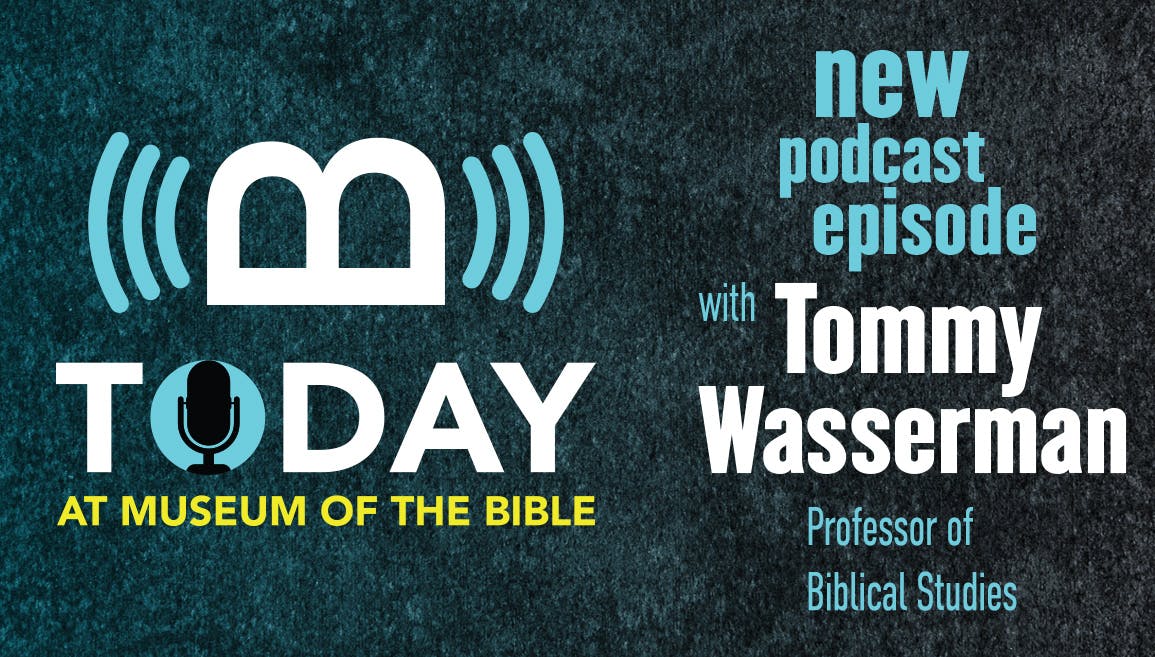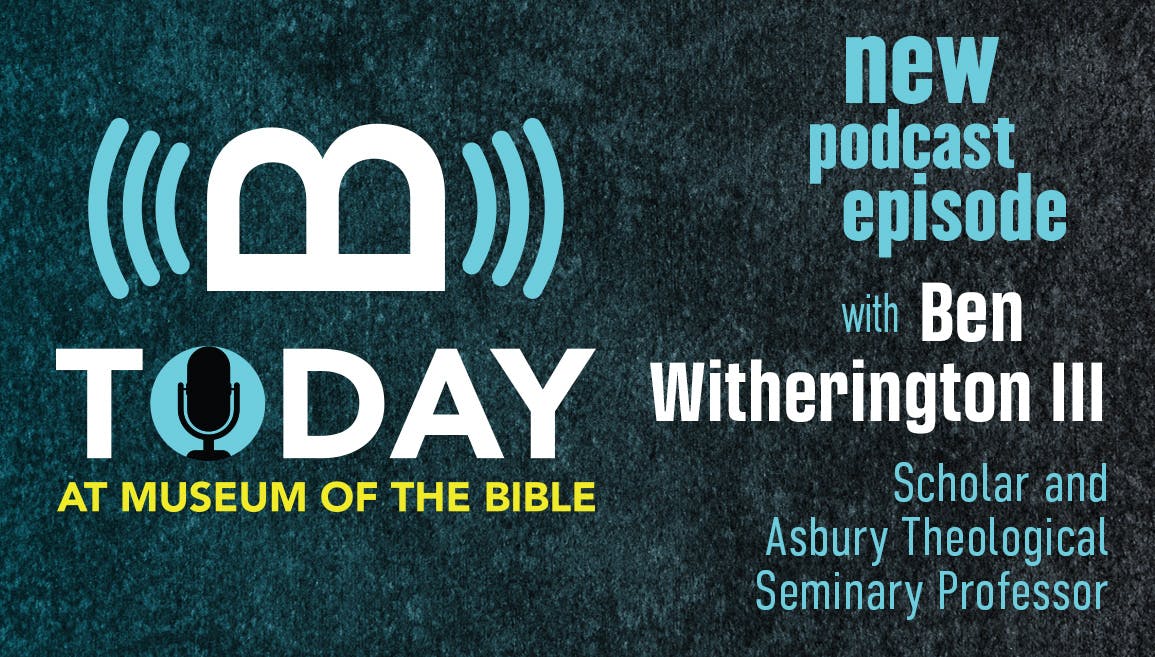From the Podcast: Dr. Tommy Wasserman

Recently, on our podcast, Today at Museum of the Bible, Chief Curatorial Officer Dr. Jeff Kloha interviewed New Testament scholar Tommy Wasserman. Below is an excerpt of their conversation.
The following interview has been edited for clarity and space. To listen to the whole interview, check it out on our podcast, Today at Museum of the Bible.
Jeff Kloha: I'm here today with Professor Tommy Wasserman, who holds a professorship in two countries. He is a professor of New Testament at the Örebro School of Theology in Sweden and a professor of biblical studies at the Ansgar Theological School in Norway. Welcome, Tommy.
Tommy Wasserman: Thank you very much. Jeff.
Jeff: Tommy Wasserman is quite the scholar of New Testament manuscripts. His first published academic work was in the book of Jude, a very comprehensive study and has continued in detailed studies of manuscripts, moving on into the Gospel of Mark and Gospel of John. Tommy, maybe just a little bit about what it's like to work directly with manuscripts.
Tommy: There are many things to learn, and you get some glimpses indirectly, mostly in Bible footnotes or so. But it’s nothing like looking at the actual, real, physical artifacts, which have changed throughout the centuries. And then minuscule, I’m talking about the various scripts of these Greek manuscripts, the original language. These are like the real fingerprints of readers throughout the centuries. You can have all sorts of marginal notation and layout and, of course, variants in the actual text which say something about the people who copied them, who used them. I am personally very interested in the history of the text and how sometimes it changed and why.
Jeff: Can you describe a few things?
Tommy: Yes, you can have all sorts of tools for reading in the manuscripts. You could say chapters, chapter headings, a different way of dividing the text. We don't find our modern chapter verse division, but other types of division. It’s very significant how you divide the text. And of course, you have liturgical markings where you would read for a certain day and the week, and also wonderful illuminations, most commonly of the evangelists.
Jeff: And notes from church fathers, and comments on the passage or themes. And some of what you’ve done, Tommy, is trace through some of these notes in different manuscripts and see how they relate to each other. And you’ve been working on the ending of Mark and have found some interesting features.
Tommy: If you didn’t know it, you have several different competing endings of the Gospel of Mark. So, there is a short ending at 16:8, and then you have an intermediate ending, and then you have the long ending, which is the rest of chapter sixteen.
Jeff: The one you find in the King James Bible is the long ending.
Tommy: So, in a modern Bible, you will probably find a footnote, probably the long ending in brackets. But in this particular family of manuscripts, you will find an editorial note, the text ended here. And Eusebius, he made his canons up to this point. But in some manuscripts, you have the rest of Mark. So, in this family of manuscripts, this editorial note has been copied, but in some later members, it's transferred to the margin.
Jeff: So, the manuscript distinguishes the actual biblical text from the editorial comment.
Tommy: Yes, you can see how this paratext, something parallel to this editorial note, how it connects and how that paratext has been copied throughout centuries and transferred in the margin. And finally disappeared.
Jeff: Interesting. And the same family members, this cluster of manuscripts has a similar note at John 7, right. At the woman caught in adultery.
Tommy: A similar critical note. What is most interesting with this family of manuscript is that the editor in the fifth century pulled that pericope out and transferred it to the end of John. And he tells that in the note that this is normally found in the 86 Canon, this kephalaia chapter. But he says, I decided because it's not found—and he refers to a number of church fathers who have not commented on this pericope—I decided to put it here instead. That's the essence of that comment. And what is very interesting with that note is that already in the fifth century, he calls this pericope a chapter of the adulterers.
Jeff: Right.
Tommy: And not as we think of chapters, but a highlight in the Gospel, a story. So that was also significant that this story was assigned a chapter. There are only normally 18 chapters in John in this Greek old system. So, this is the 19th chapter, so to speak. So, it’s not that surprising they deserve special comment. And they have it also in our modern Bibles. You can look up John 7:53, the story that begins there, and Mark 16, and you will probably find a footnote talking about the critical questions.
Jeff: So, you are also a member of the editorial committee for what's called the Editio Critica Maior.
Tommy: I'm a member of a steering committee because we organize these meetings at the Society of Biblical Literature. I'm involved through the International Greek New Testament Project, which is an umbrella organization, and the scientific advisory board for the publication of some of the volumes.
Jeff: So, what is that project trying to do?
Tommy: So, the Nestle-Aland edition, which is widely used by seminarians and theological students, it's a hand edition. It's just a very small selection of data from manuscripts. You have data from so many great manuscripts which are important, but which couldn't fit in the small hand edition. So work is ongoing, and you may not believe it, but all the Greek New Testament manuscripts, and there are thousands have not yet been examined fully. And their contribution, these are all witnesses to the text, but it takes generations to study all of this data.
Jeff: The volumes are also online and you can access all the data.
Tommy: You can click a symbol for a certain manuscript and there you also get an image from that manuscript. Nowadays, so much information is available online in the New Testament Virtual Manuscript Room. Of course, some manuscripts are now digitized afresh and there are fantastic color images available of the most important manuscripts.
Jeff: Tom, could you say just a little bit about your teaching and research work.
Tommy: I teach mainly Greek New Testament. I have language courses, and in those courses, you can give some introduction to New Testament textual criticism and manuscript [studies] and so on. But that’s on a small scale, so I don’t get to teach as much from my research as I would have liked to. Then I supervise various types of research, bachelor’s and master’s thesis. So, I’ve published, I love to do research, and there are always new things to discover.
Jeff: So why are you here at the Museum of the Bible?
Tommy: There is now an ongoing Logos workshop (sponsored in part by the museum), and I am holding some language seminars for beginner Greek and advanced, and we are reading Greek from manuscripts. And we have manuscripts to look at here at the museum, and it's something else to have close contact to the actual sources and to understand the whole context of the text.
Jeff: And to have scholars like you to be able to interact with is a real benefit to the students. If you're interested in the Logos seminars, then keep your eyes on the Museum of the Bible web page. Tommy, it's great to have you here, and I'll look forward to your next article.


